In Chapter 3 of Michael Schudson’s book, Discovering the News, he discusses journalism as entertainment from Joseph Pulitzer and the New York World, and journalism as information from the rise of the New York Times.
Shudson begins the chapter by discussing how at the beginning of the nineteenth century, there was always a division among reporters. Even though the ideology behind reporters were quite similar, there was much that divided the identities of the newspapers for which they worked. The two biggest papers by the end of the 19th century were Joseph Pulitzer’s the World, and the Journal, which was bought and revived by William Randolph Hearst. This was known as “new journalism” at the time.

Political cartoon illustrating the ongoing war between Joseph Pulitzer and William Randolph Hearst
As the introduction to this chapter ends, it discusses the ups and downs and long roads of each paper on the way to success. It also brings us to a series of questions. Why did certain social classes read one particular newspaper and not the other? Who makes the judgement that the informational ideal in journalism is associated with fairness and objectivity? It then brings the reader to this question: what is the meaning of the two journalisms of the 1890s?
This part of the chapter starts out on how Pulitzer gained success early on in his career. This guy could do it all as he worked his way up top quite quickly. He fought in the Civil War, then became a reporter, then ended up buying the St. Louis Post and Dispatch in 1878. After this he bought the New York World and the rest is history.

Joseph Pulitzer back in his prime
The relationship between newspapers and advertisers dramatically changed in the 1880s due to the two newspapers constantly in battle. Also, due to the growth of department stores and development of brand names by national manufacturing concerns, businesses sky rocketed. As a result, in 1887 the American Newspapers Publishers Association was formed.
Pulitzer wanted the World to provide both editorial leadership and news. He wanted the World to be “both a daily school-house and a daily forum–both a daily teacher and a daily tribune.” According to Schudson, something like this was very unusual at the time.
William Randolph Hearst once said, “it is the Journal’s policy to engage brains as well as to get the news, for the public is even more fond of entertainment than it is of information.” It was time for the newspaper to serve its three main functions: to inform, to interpret, and most of all, entertain.


The New York Times and New York World both had different ways of catching the public's eye
As Shudson says at the beginning of this section, “the World may have set the pace for modern mass-circulation journalism, but after 1896 the New York Times established the standard.” This is completely true. The most successful newspaper is clearly the best newspaper. If people are buying that paper the most, then it must be the best.
The New York Times wrote for the rational person or the person whose life was orderly, while the World had a sense that everything was new and unpredictable. This was just a few of the things that were common amongst both papers at the time.
Throughout much of the end of this century and the beginning of the 20th century, Pulitzer and Hearst had their ongoing battles. Without these two men, who knows what journalism would have been like. These two changed how people perceived journalism and people’s opinions on it forever. Schudson puts it perfectly. The New York Times and New York World and the war between Pulitzer and Hearst “influenced journalism in the 1920s and 1930s and gave rise to the ideal of objectivity as we know it.”

Leave a response